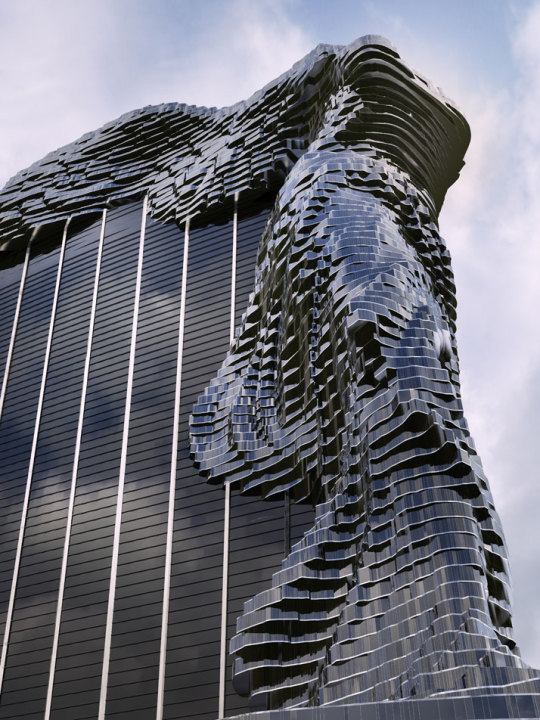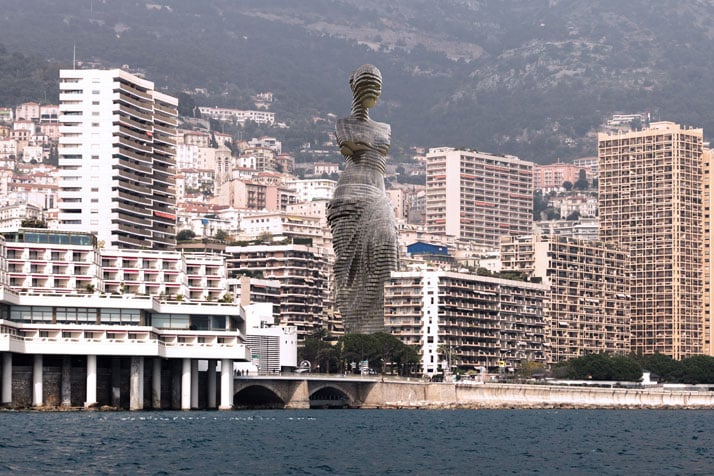Many people--myself included--sometimes forget how extensive the ancient Hellenic empire was. It wasn't just what is now modern Greece. It extended all the way to, for example, the Ukraine. Today: Chersonesos.
Chersonesos (Χερσόνησος, Khersonesos) is an ancient Hellenic colony founded in the 6th century BC and is located on the shore of the Black Sea at the outskirts of Sevastopol on the Crimean Peninsula, where it is referred to as 'Khersones'. The name 'Chersonesos' in Greek means 'peninsula', and aptly describes the site on which the colony was established. It was sometimes combined with supplemental monikers to denote its location, as in Tauric Chersonesos (that is, in the land of the Taurian tribes) found in the work of the author Arrian. It should not be confused with the Tauric Chersonese itself as that name often applied to the whole of the southern Crimea.
In Ancient Hellas, colonies were sometimes founded by vanquished people, who left their homes to escape subjection at the hand of a foreign enemy; sometimes as a sequel to civil disorders, when the losers in internecine battles left to form a new city elsewhere; sometimes to get rid of surplus population, and thereby to avoid internal convulsions; and sometimes as a result of ostracism. But in most cases the motivation was to establish and facilitate relations of trade with foreign countries and further the wealth of the Hellenic metropolis--mother country.
The exact time of and circumstances surrounding the foundation of Chersonesos remain highly spculative. Information about the initial period of the history of the polis is isolated and fragmentary. The earliest reference dating to the mid 4th century BC is found in the Periplous by Pseudo-Skilakes in which Chersonesos is referred to as a trading city.
Chersonesos was founded by Dorians from Heraklea Pontica (present-day Eregli, Turkey) significantly later than the majority of Greek cities in the northern Black Sea region. The territory was previously inhabited by the Taurians, a tribe less readily competent to establish close ties with the Greeks than other aboriginal inhabitants of Crimea. These factors influenced both the subsequent history of Chersonesos and its governmental structure.
Chersonesos remained a relatively small city until approximately the middle of the 4th century BC. It can be surmised that Greek maritime transit trade constituted a significant part of the city's earliest economy. Chersonesos, as the northern Black Sea city in closest proximity to the Pontis, lay in an extremely auspicious location on naval trade routes. All ships traveling from the southern Black Sea coast or from Greece to the northern Black Sea region crossed the Pontis Euxine (Black Sea) and stopped at Chersonesos en route to their destinations. But the advantages of this location did not become apparent until the early 4th century BC at which time the ancient Hellenes began to use the direct route from Sinope across the Black Sea to Chersonesos. According to numismatic evidence, the role of Chersonesos as a leading transit point for maritime trade continued into later periods.
The situation in the city begins to change in the 4th century B.C. The development of the Heraklean Peninsula begins with the appearance of the first large military-industrial settlement in the second quarter of the century at so-called Lighthouse Point, ten kilometers from Chersonesos. In contemporary scholarship this area is named Strabo's Old Chersonesos. It is probable that in the second half of the 4th century BC Chersonesos encompassed the rest of the Heraklean Peninsula, the territory which becomes the agricultural basis of the polis until the end of its existence. It may be that because this was a condition specific to many Dorian polises the development of the Heraklean Peninsula resulted in the expulsion and/or perhaps enforced submission of a part of the local Taurian population.
Around the beginning of the 4th century BC began the expansion of Chersonesos into the fertile plains of northwestern Crimea, a consequence of which was the subordination of Kerkinitis and the economic development of a wide agricultural territory in the second half of the century. Many fortresses and unfortified settlements were built, while land was divided into plots. The precise progression of events connected with the territorial expansion of Chersonesos is not clear, although the process of expansion may have occurred militarily, especially if this phenomenon collided with the interests of the Scythians and perhaps even Olbia, with whom Kerkinitis was closely tied.
The transformation of Chersonesos into a formidable state entity with extensive land holdings and a well-developed agricultural infrastructure based on the production of grapes and grain raised it to the level of a leading Black Sea polis. The height of economic and cultural development in Chersonesos occurs in the second half of the 4th-3rd century BC and is well-documented in the archaeological results of the ancient city.
During much of the classical period Chersonesus was a democracy ruled by a group of elected archons and a council called the Demiurgi. As time passed the government grew more oligarchic, with power concentrated in the hands of the archons. A form of oath sworn by all the citizens since the 3rd century BC has survived to the present day:
Already in the 3rd century BC a general shake-up took place in the military-political situation of the northern Black Sea region. From the very beginning Chersonesos co-existed with various belligerent tribes and peoples, among them the Taurians and Scythians, against whom the city had to defend itself countless times, both defensively and offensively during its territorial expansion.
In the first third of the century the majority of settlements in the chora of Chersonesos succumbed to the invasions. This situation may possibly be connected to the growing abilities of the Scythians, or what is more probable, the Sarmatian incursion into the Don-Dnipro region. Archaeological evidence points to the fact that Chersonesos entered the 2nd century B.C. in a weakened state, and consequently was subject to the power of stronger political and economic shocks.
After the appearance of the Scythian state with its capital in Neapolis in the 3rd century BC, the Scythians increased their pressure on Chersonesos. Scythian fortified settlements were built dangerously close to the city of Chersonesos. The city's lack of a military force capable of withstanding the Scythians resulted in its search for allies. In 179 BC Chersonesos concluded a treaty with Pontic king Pharnakes I, who pledged his assistance in any struggles against the Scythians. In the late 2nd century BC renewed Scythian pressure on Chersonesos forced the city to apply to King Mithradates VI Eupator, the grandson of Pharnakes I, for aid. This petition established the beginning of a new stage in the political history of the northern Black Sea region. Mithradates' intervention saved Chersonesos from the Scythian danger, although the city lost its political independence in the process and, together with Bosporos, joined the Pontic State of Mithridates .
After Rome subdued the kingdom of Mithradates VI Eupator, Chersonesos found itself subordinate to Bosporos and remained so until Julius Caesar granted the city its independence in 46-45 B.C. After Caesar's death the Bosporan king Asandros attempted to subordinate Chersonesos once again, but the city successfully retained its independence. Around 25-24 BC Augustus normalized relations between the Chersonesan civil community and the Bosporan dynasts. Under the initiative of the Roman administration, Bosporos and Chersonesos created a defensive union which existed until war broke out between Rome and Bosporos. Chersonesos joined the side of Rome during the war, after which Chersonesos was granted certain privileges. Throughout this period Chersonesos maintained a Roman garrison an thrived.
In the period spanning from the first centuries AD to the advent of Christianity the worldview of the population of Chersonesos developed in two related, but at the same time alternate, directions. In the first, the cults of Hellenistic deities were still popular. All the deities retained their traditional functions, attributes, and symbols. As in the past, the main cult was that of the city's patroness, Parthenos (Maiden). In addition, the cults of many Olympic Gods received special attention. Historical factors, such as the strengthening of ties with the Roman Empire, influenced the selection of deity worship according to Roman taste, and Roman emperors occasionally chose to cultivate the most popular Hellenistic deities, such as Aphrodite, Apollo, and Asklepios, according to the needs of their policy.
Chersonesos became a Byzantine possession during the Early Middle Ages and withstood a siege by the Göktürks in 581. Byzantine rule was slight: there was a small imperial garrison more for the town's protection than for its control. It was useful to Byzantium in two ways: as an observation point to watch the barbarian tribes, and its isolation made it a popular place of exile for those who angered the Roman and later Byzantine governments. After the Fourth Crusade (1202–04), Chersonesus became dependent on the Byzantine Empire of Trebizond, and then fell under Genoese control in the early 13th century. In 1299, the town was sacked by the Mongol armies of Nogai Khan's Golden Horde.
Chersonesus' ancient ruins are presently located in one of Sevastopol's suburbs. They were excavated by the Russian government, starting from 1827. The buildings mix influences of Greek, Roman and Byzantine culture. The defensive wall was approximately 3.5 kilometres (2.2 mi) long, 3.5 to 4 metres wide and 8 to 10 metres high with towers at a height of 10 to 12 metres. The walls enclosed an area of about 30 hectares (74 acres). Buildings include a Roman amphitheatre and a Greek temple.
The surrounding land under the control of the city, the chora, consists of several square kilometres of ancient but now barren farmland, with remains of wine presses and defensive towers. According to archaeologists, the evidence suggests that the locals were paid to do the farm work instead of being enslaved.
The excavated tombstones hint at burial practices that were different from the Greek ones. Each stone marks the tomb of an individual, instead of the whole family and the decorations include only objects like sashes and weapons, instead of burial statues. Over half of the tombs archaeologists have found have bones of children. Burned remnants suggest that the city was plundered and destroyed. The site is now part of the National Preserve of Tauric Chersonesos. In 2013, Chersonesus was listed as a World Heritage Site.
Chersonesos (Χερσόνησος, Khersonesos) is an ancient Hellenic colony founded in the 6th century BC and is located on the shore of the Black Sea at the outskirts of Sevastopol on the Crimean Peninsula, where it is referred to as 'Khersones'. The name 'Chersonesos' in Greek means 'peninsula', and aptly describes the site on which the colony was established. It was sometimes combined with supplemental monikers to denote its location, as in Tauric Chersonesos (that is, in the land of the Taurian tribes) found in the work of the author Arrian. It should not be confused with the Tauric Chersonese itself as that name often applied to the whole of the southern Crimea.
In Ancient Hellas, colonies were sometimes founded by vanquished people, who left their homes to escape subjection at the hand of a foreign enemy; sometimes as a sequel to civil disorders, when the losers in internecine battles left to form a new city elsewhere; sometimes to get rid of surplus population, and thereby to avoid internal convulsions; and sometimes as a result of ostracism. But in most cases the motivation was to establish and facilitate relations of trade with foreign countries and further the wealth of the Hellenic metropolis--mother country.
The exact time of and circumstances surrounding the foundation of Chersonesos remain highly spculative. Information about the initial period of the history of the polis is isolated and fragmentary. The earliest reference dating to the mid 4th century BC is found in the Periplous by Pseudo-Skilakes in which Chersonesos is referred to as a trading city.
Chersonesos was founded by Dorians from Heraklea Pontica (present-day Eregli, Turkey) significantly later than the majority of Greek cities in the northern Black Sea region. The territory was previously inhabited by the Taurians, a tribe less readily competent to establish close ties with the Greeks than other aboriginal inhabitants of Crimea. These factors influenced both the subsequent history of Chersonesos and its governmental structure.
Chersonesos remained a relatively small city until approximately the middle of the 4th century BC. It can be surmised that Greek maritime transit trade constituted a significant part of the city's earliest economy. Chersonesos, as the northern Black Sea city in closest proximity to the Pontis, lay in an extremely auspicious location on naval trade routes. All ships traveling from the southern Black Sea coast or from Greece to the northern Black Sea region crossed the Pontis Euxine (Black Sea) and stopped at Chersonesos en route to their destinations. But the advantages of this location did not become apparent until the early 4th century BC at which time the ancient Hellenes began to use the direct route from Sinope across the Black Sea to Chersonesos. According to numismatic evidence, the role of Chersonesos as a leading transit point for maritime trade continued into later periods.
The situation in the city begins to change in the 4th century B.C. The development of the Heraklean Peninsula begins with the appearance of the first large military-industrial settlement in the second quarter of the century at so-called Lighthouse Point, ten kilometers from Chersonesos. In contemporary scholarship this area is named Strabo's Old Chersonesos. It is probable that in the second half of the 4th century BC Chersonesos encompassed the rest of the Heraklean Peninsula, the territory which becomes the agricultural basis of the polis until the end of its existence. It may be that because this was a condition specific to many Dorian polises the development of the Heraklean Peninsula resulted in the expulsion and/or perhaps enforced submission of a part of the local Taurian population.
Around the beginning of the 4th century BC began the expansion of Chersonesos into the fertile plains of northwestern Crimea, a consequence of which was the subordination of Kerkinitis and the economic development of a wide agricultural territory in the second half of the century. Many fortresses and unfortified settlements were built, while land was divided into plots. The precise progression of events connected with the territorial expansion of Chersonesos is not clear, although the process of expansion may have occurred militarily, especially if this phenomenon collided with the interests of the Scythians and perhaps even Olbia, with whom Kerkinitis was closely tied.
The transformation of Chersonesos into a formidable state entity with extensive land holdings and a well-developed agricultural infrastructure based on the production of grapes and grain raised it to the level of a leading Black Sea polis. The height of economic and cultural development in Chersonesos occurs in the second half of the 4th-3rd century BC and is well-documented in the archaeological results of the ancient city.
During much of the classical period Chersonesus was a democracy ruled by a group of elected archons and a council called the Demiurgi. As time passed the government grew more oligarchic, with power concentrated in the hands of the archons. A form of oath sworn by all the citizens since the 3rd century BC has survived to the present day:
"I swear by Zeus, Gaia, Helios, the Virgin (Parthenos), the Olympian gods and goddesses, and the heroes who protect the city and territory and fortified places of the Chersonesitans: I will co-operate to defend the safety and freedom of the city and the citizens, and I will not betray Chersonesos or Kerkinitis or Kalos Limen or any other fortified town or other places which the Chersonesitans inhabit or have inhabited, to anyone either Greek or barbarian, but I will protect them for the people of Chersonesos. I will not abolish the democracy, nor will I support or conceal anyone who plans to betray or abolish the democracy, but I will report them to the damiourgoi in the city. I will be the enemy of anyone who plots against or betrays or foments revolt in Chersonesos or Kerkinitis or Kalos Limen or the fortified places and territory of the Chersonesitans. I will give the best and fairest practical assistance and advice to the city and the citizens. I will preserve the (?) safety {sastēr} of the people, and I will not reveal any secrets to anyone, Greek or barbarian, which could cause harm to the city. I will not give or receive any gift for the sake of harming the city and the citizens, nor will I plot any evil deed against any of the citizens, unless they are in revolt; nor will I support or conceal anyone who plots such things, but I will report them and vote against them according to the laws. I will not join any conspiracy against the state of Chersonesos nor against any of the citizens unless they have been declared to be enemies of the people. If I have joined any conspiracy or if I have been bound by any oath or curse, if I put an end to it may it turn out well for myself and my kin, but if I abide by it, may the opposite occur. If I detect any conspiracy that already exists, or is being formed, I will report it to the damiourgoi. I will not give away corn to be removed from the plain, nor will I take it anywhere else away from the plain, except to Chersonesos. By Zeus and Gaia and Helios and the Virgin and the Olympian gods, if I abide by this oath, may it turn out well for myself and my family and my associates, but if I do not abide by it, may it turn out badly for myself and my family and my associates; may neither the land nor the sea bear fruit for me; may my women fail to bear any children . . . "
Already in the 3rd century BC a general shake-up took place in the military-political situation of the northern Black Sea region. From the very beginning Chersonesos co-existed with various belligerent tribes and peoples, among them the Taurians and Scythians, against whom the city had to defend itself countless times, both defensively and offensively during its territorial expansion.
In the first third of the century the majority of settlements in the chora of Chersonesos succumbed to the invasions. This situation may possibly be connected to the growing abilities of the Scythians, or what is more probable, the Sarmatian incursion into the Don-Dnipro region. Archaeological evidence points to the fact that Chersonesos entered the 2nd century B.C. in a weakened state, and consequently was subject to the power of stronger political and economic shocks.
After the appearance of the Scythian state with its capital in Neapolis in the 3rd century BC, the Scythians increased their pressure on Chersonesos. Scythian fortified settlements were built dangerously close to the city of Chersonesos. The city's lack of a military force capable of withstanding the Scythians resulted in its search for allies. In 179 BC Chersonesos concluded a treaty with Pontic king Pharnakes I, who pledged his assistance in any struggles against the Scythians. In the late 2nd century BC renewed Scythian pressure on Chersonesos forced the city to apply to King Mithradates VI Eupator, the grandson of Pharnakes I, for aid. This petition established the beginning of a new stage in the political history of the northern Black Sea region. Mithradates' intervention saved Chersonesos from the Scythian danger, although the city lost its political independence in the process and, together with Bosporos, joined the Pontic State of Mithridates .
After Rome subdued the kingdom of Mithradates VI Eupator, Chersonesos found itself subordinate to Bosporos and remained so until Julius Caesar granted the city its independence in 46-45 B.C. After Caesar's death the Bosporan king Asandros attempted to subordinate Chersonesos once again, but the city successfully retained its independence. Around 25-24 BC Augustus normalized relations between the Chersonesan civil community and the Bosporan dynasts. Under the initiative of the Roman administration, Bosporos and Chersonesos created a defensive union which existed until war broke out between Rome and Bosporos. Chersonesos joined the side of Rome during the war, after which Chersonesos was granted certain privileges. Throughout this period Chersonesos maintained a Roman garrison an thrived.
In the period spanning from the first centuries AD to the advent of Christianity the worldview of the population of Chersonesos developed in two related, but at the same time alternate, directions. In the first, the cults of Hellenistic deities were still popular. All the deities retained their traditional functions, attributes, and symbols. As in the past, the main cult was that of the city's patroness, Parthenos (Maiden). In addition, the cults of many Olympic Gods received special attention. Historical factors, such as the strengthening of ties with the Roman Empire, influenced the selection of deity worship according to Roman taste, and Roman emperors occasionally chose to cultivate the most popular Hellenistic deities, such as Aphrodite, Apollo, and Asklepios, according to the needs of their policy.
Chersonesos became a Byzantine possession during the Early Middle Ages and withstood a siege by the Göktürks in 581. Byzantine rule was slight: there was a small imperial garrison more for the town's protection than for its control. It was useful to Byzantium in two ways: as an observation point to watch the barbarian tribes, and its isolation made it a popular place of exile for those who angered the Roman and later Byzantine governments. After the Fourth Crusade (1202–04), Chersonesus became dependent on the Byzantine Empire of Trebizond, and then fell under Genoese control in the early 13th century. In 1299, the town was sacked by the Mongol armies of Nogai Khan's Golden Horde.
Chersonesus' ancient ruins are presently located in one of Sevastopol's suburbs. They were excavated by the Russian government, starting from 1827. The buildings mix influences of Greek, Roman and Byzantine culture. The defensive wall was approximately 3.5 kilometres (2.2 mi) long, 3.5 to 4 metres wide and 8 to 10 metres high with towers at a height of 10 to 12 metres. The walls enclosed an area of about 30 hectares (74 acres). Buildings include a Roman amphitheatre and a Greek temple.
The surrounding land under the control of the city, the chora, consists of several square kilometres of ancient but now barren farmland, with remains of wine presses and defensive towers. According to archaeologists, the evidence suggests that the locals were paid to do the farm work instead of being enslaved.
The excavated tombstones hint at burial practices that were different from the Greek ones. Each stone marks the tomb of an individual, instead of the whole family and the decorations include only objects like sashes and weapons, instead of burial statues. Over half of the tombs archaeologists have found have bones of children. Burned remnants suggest that the city was plundered and destroyed. The site is now part of the National Preserve of Tauric Chersonesos. In 2013, Chersonesus was listed as a World Heritage Site.















